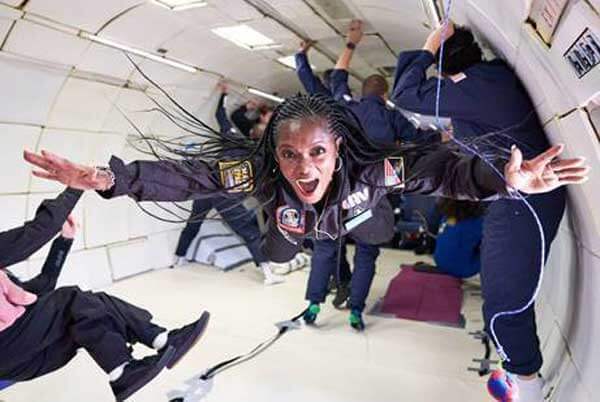
LONG BEACH, Calif., October 18, 2021 (AstroAccess PR) – AstroAccess, an initiative dedicated to advancing disability inclusion in space exploration, and Zero Gravity Corporation (ZERO-G) successfully completed a parabolic flight with a crew of 12 ambassadors with mobility, vision, and hearing disabilities on Sunday, October 17.
On Sunday, the ZERO-G aircraft ascended to an altitude of 32,000 feet, at which point the vehicle commenced its parabolic maneuvers. Ambassadors carried out planned demonstrations over the course of 15 arcs, experiencing multiple minutes of weightlessness.
During the flight, the ambassadors conducted demonstrations to understand how space vessels can be made more accessible by design and procedure. These tests included new visual and haptic feedback mechanisms to signify phases of flight, crew uniforms intentionally designed for accessibility, interior customizations to provide instantaneous location and orientation awareness for safety in microgravity, and a variety of other additional scientific and technical demonstrations.
Anna Voelker, Executive Director of SciAccess and Co-Project Lead of AstroAccess, said, “Space removes the barriers between people; now is the time to remove the barriers to space itself.” They continued, “AstroAccess is sending a message to people who have historically been excluded from STEM that not only is there room for you in space, there is a need for you.”
The mission was supported by a wide range of disability and space organizations, including DAV (Disabled American Veterans), Gallaudet University, the Massachusetts Association for the Blind and Visually Impaired, the Space Frontier Foundation, the Lighthouse for the Blind and Visually Impaired, and the Whitesides Foundation. The AstroAccess mission was part of SciAccess and under fiscal sponsorship of Yuri’s Night. A full list of partners is below.
In addition to the 12 ambassadors, onboard the flight were members of several American companies flying crewed spaceflight vehicles.
The mission not only provides valuable insights on the future of spacecraft design, but also seeks to advance disability inclusion in STEM, inspire the next generation of scientists and world-changers, welcome new perspectives into the science community, and demonstrate the benefit of intentional and accessible design in space and here on Earth.
George Whitesides, Co-Project Lead of AstroAccess, said: “Yesterday’s successful flight was an important milestone in our mission to open space for all. The tasks and demonstrations carried out by our ambassadors will have a profound effect on the space industry at large, inform the design of future space vehicles, and pave the way for future astronauts with disabilities.”
“One characteristic veterans share is the unwavering desire to serve, and it’s an inclination that continues for many once they no longer wear our nation’s uniform,” said Marc Burgess, CEO and national adjutant of DAV. “We’re incredibly grateful to AstroAccess for giving our ambassador CeCe Mazyck the opportunity to contribute to vital research that will integrate disabled veterans and civilians alike into space and benefit the disabled community and humanity for years to come.”
Sina Bahram, Flight 1 AstroAccess Ambassador: “Floating in microgravity was the truest physical manifestation of pure joy and delight that I have ever felt in my life. I feel this joy because of the visceral nature of the experience, the progress being made by and for people with disabilities, the more inclusive future we are building, and the recognition that such a future will not exist without us.”
About AstroAccess
AstroAccess is dedicated to advancing disability inclusion in space exploration for the benefit of humankind. The first mission flew on 17 October, 2021. The ultimate goal of AstroAccess is to fly one or more team members to space in the coming years. The project is supported through the Whitesides Foundation and is part of SciAccess, an international organization dedicated to advancing disability inclusion in STEM. The fiscal sponsor of the project is Yuri’s Night, a non-profit space advocacy organization.
Partner organizations include Disabled American Veterans, the Lighthouse for the Blind and Visually Impaired, the Space Frontier Foundation, the Massachusetts Association for the Blind and Visually Impaired, the Jean Maggi Foundation, and the Royal Academy of Science International Trust. Educational institutions that support the mission include Gallaudet University, MIT Media Lab Space Exploration Initiative, California State University Long Beach, Stanford Medicine Abilities Coalition, The Ohio State University Department of Astronomy, Edinboro University, and UCSD’s Arthur C. Clarke Center for Human Imagination. Corporate supporters include People Love Art, FTI Consulting, Virgin Orbit, Relativity Space, Soundbrenner, Stellar Amenities, See3D, and ThinkSpace Mission Consulting. The mission was also supported by other prominent space organizations including AIAA, Disabled for Accessibility in Space, Space for Humanity, Aspen Science Center, the Center for Lunar and Asteroid Surface Sciences, Solar System Exploration Research Virtual Institute (SSERVI) and the Astronomical Society of the Pacific.
AstroAccess Ambassadors
Sina Bahram
Dana Bolles
Mary Cooper
Eric Ingram
Centra Mazyck
Mona Minkara
Viktoria Modesta
Zuby Onwuta
Sawyer Rosenstein
Eric Shear
Apurva Varia
Sheri Wells-Jensen
– Advertisement –